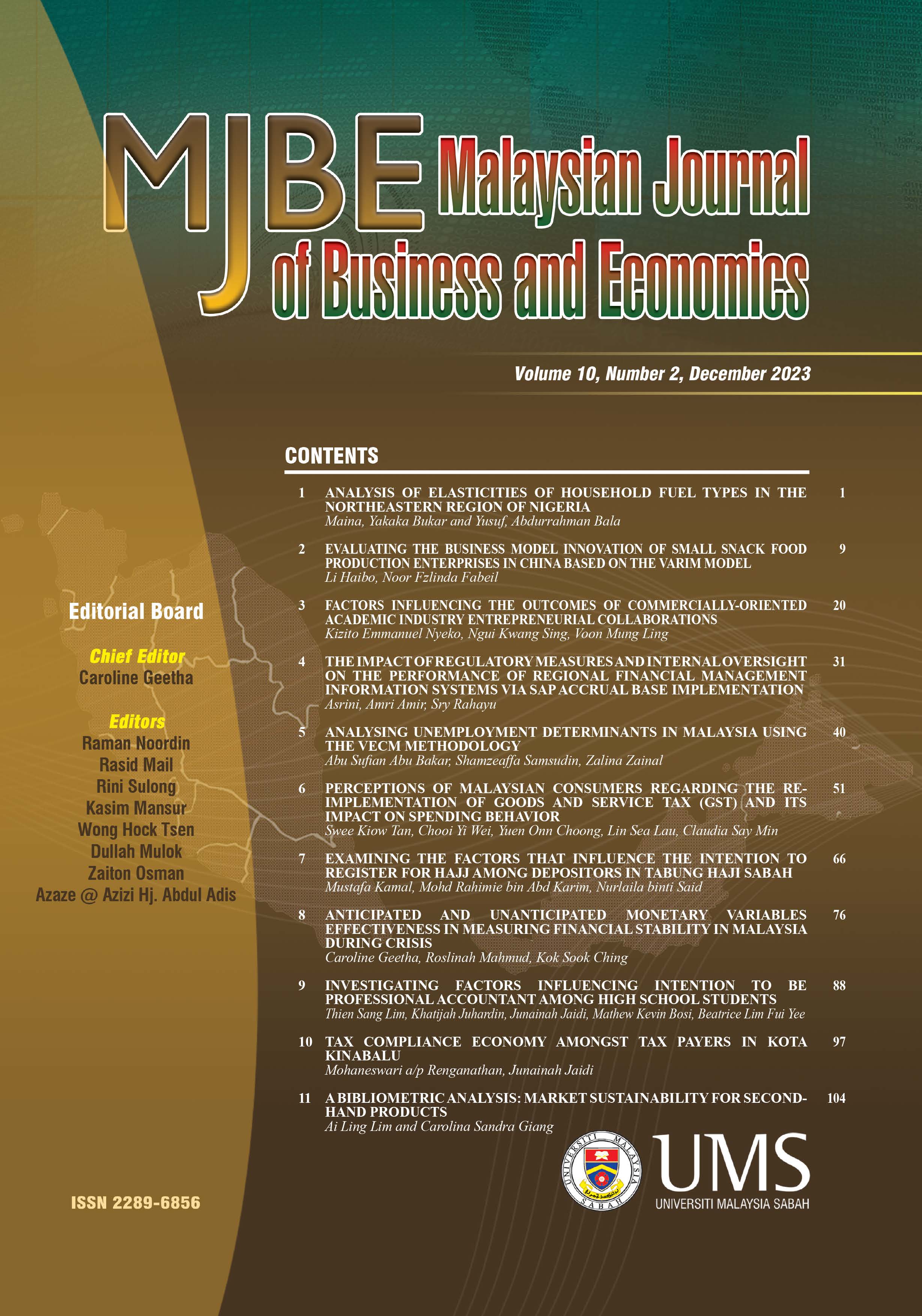EVALUATING THE BUSINESS MODEL INNOVATION OF SMALL SNACK FOOD PRODUCTION ENTERPRISES IN CHINA BASED ON THE VARIM MODEL
DOI:
https://doi.org/10.51200/mjbe.v10i2.4811Keywords:
business model innovation, VARIM, snack food, questionnaire, digital technologyAbstract
This paper examines the business model innovation situation, evaluation, and key factors of small snack food production enterprises in China and provides suggestions for enterprises. A questionnaire designed using the VARIM model evaluates business model innovation based on five aspects, combined with the influential role of relational resources, digital technology, and long tail theory. It is hypothesized that relational resources, digital technology, and long tail theory have a positive impact on business model innovation, and that the VARIM model assesses profitability potential. It is hypothesized that firms should utilize these factors for business model innovation to improve competitiveness and sustainability. The findings and conclusions of this paper are based on assumptions and speculations, which need to be verified and corrected by subsequent practical investigations.
References
Afuah, A. (2014). Business Model Innovation: Concepts, Analysis, and Cases. Routledge.
Amit, R., & Zott, C. (2012). Creating Value Through Business Model Innovation. MIT Sloan Management Review.
Anderson, C. (2008). CHRIS ANDERSON| THE LONG TAIL.
Baden-Fuller, C., & Haefliger, S. (2013). Business models and technological innovation. Long Range Planning, 46(6), 419–426. https://doi.org/10.1016/j.lrp.2013.08.023
Bharadwaj, A., El Sawy, O. A., University of Southern California, Pavlou, P. A., Temple University, Venkatraman, N., & Boston University. (2013). Digital Business Strategy: Toward a next generation of insights. MIS Quarterly, 37(2), 471–482. https://doi.org/10.25300/MISQ/2013/37:2.3
Casadesus-Masanell, R., & Zhu, F. (2013). Business model innovation and competitive imitation: The case of sponsor-based business models. Strategic Management Journal, 34(4), 464–482. https://doi.org/10.1002/smj.2022
Chesbrough, H. (2010). Business model innovation: Opportunities and barriers. Long Range Planning, 43(2–3), 354–363. https://doi.org/10.1016/j.lrp.2009.07.010
Chesbrough, H. W. (2003). Open innovation: The new imperative for creating and profiting from technology. Harvard Business Press.
Clauss, T. (2017). Measuring business model innovation: Conceptualization, scale development, and proof of performance. R&D Management, 47(3), 385–403. https://doi.org/10.1111/radm.12186
Cosenz, F., & Noto, G. (2018). A dynamic business modelling approach to design and experiment new business venture strategies. Long Range Planning, 51(1), 127–140. https://doi.org/10.1016/j.lrp.2017.07.001
Demil, B., & Lecocq, X. (2010). Business Model Evolution: In Search of Dynamic Consistency. Long Range Planning, 43(2–3), 227–246. https://doi.org/10.1016/j.lrp.2010.02.004
Demil, B., Lecocq, X., Ricart, J. E., & Zott, C. (2015). Introduction to the SEJ special issue on business models: Business models within the domain of strategic entrepreneurship. Strategic Entrepreneurship Journal, 9 (1), 1–11. Wiley Online Library.
Doz, Y. L., & Kosonen, M. (2010). Embedding strategic agility: A leadership agenda for accelerating business model renewal. Long Range Planning, 43(2–3), 370–382. https://doi.org/10.1016/j.lrp.2009.07.006
Dyer, J. H., & Chu, W. (2003). The Role of Trustworthiness in Reducing Transaction Costs and Improving Performance: Empirical Evidence from the United States, Japan, and Korea. Organization Science, 14(1), 57–68. https://doi.org/10.1287/orsc.14.1.57.12806
Eggert, A., Ulaga, W., Frow, P., & Payne, A. (2018). Conceptualizing and communicating value in business markets: From value in exchange to value in use. Industrial Marketing Management, 69, 80–90. https://doi.org/10.1016/j.indmarman.2018.01.018
Foss, N. J., & Saebi, T. (2017). Fifteen years of research on business model innovation: How far have we come, and where should we go? Journal of Management, 43(1), 200–227. https://doi.org/10.1177/0149206316675927
Franco, M., Minatogawa, V., Duran, O., Batocchio, A., & Quadros, R. (2021). Opening the Dynamic Capability Black Box: An Approach to Business Model Innovation Management in the Digital Era. IEEE Access, 9, 69189–69209. https://doi.org/10.1109/ACCESS.2021.3077849
Fu, N. (2015). The role of relational resources in the knowledge management capability and innovation of professional service firms. Human Relations, 68(5), 731–764. https://doi.org/10.1177/0018726714543479
Lavie, D. (2006). The Competitive Advantage of Interconnected Firms: An Extension of the Resource-Based View. Academy of Management Review, 31(3), 638–658. https://doi.org/10.5465/amr.2006.21318922
Lusch, R. F., & Nambisan, S. (2015). Service innovation. MIS Quarterly, 39(1), 155–176. https://doi.org/10.25300/MISQ/2015/39.1.07
Osterwalder, A., & Pigneur, Y. (2010). Business Model Generation: A Handbook for Visionaries, Game Changers, and Challengers. John Wiley & Sons.
Pisano, P., Pironti, M., & Christodoulou, I. P. (2014). The open long tail model between new culture and digital technology. Sinergie Italian Journal of Management, 32(Jan-Apr), 79–93.
Rayna, T., & Striukova, L. (2016). 360° Business Model Innovation: Toward an Integrated View of Business Model Innovation: An integrated, value-based view of a business model can provide insight into potential areas for business model innovation. Research-Technology Management, 59(3), 21–28. https://doi.org/10.1080/08956308.2016.1161401
Rochet, J.-C., & Tirole, J. (2003). Platform Competition in Two-Sided Markets. Journal of the European Economic Association, 1(4), 990–1029. https://doi.org/10.1162/154247603322493212
Story, V., Hart, S., & O’Malley, L. (2009). Relational resources and competencies for radical product innovation. Journal of Marketing Management, 25(5–6), 461–481. https://doi.org/10.1362/026725709X461803
Teece, D. J. (2010). Business models, business strategy and innovation. Long Range Planning, 43(2–3), 172–194. https://doi.org/10.1016/j.lrp.2009.07.003
Teece, D. J. (2018). Business models and dynamic capabilities. Long Range Planning, 51(1), 40–49. https://doi.org/10.1016/j.lrp.2017.06.007
Ulaga, W., & Chacour, S. (2001). Measuring customer-perceived value in business markets: A prerequisite for marketing strategy development and implementation. Industrial Marketing Management, 30(6), 525–540. https://doi.org/10.1016/S0019-8501(99)00122-4
Ziólkowska, M. (2014). Relational resources management as source of company’s innovativeness and competitive advantage. Journal of Economics, Business and Management, 2(3).
Zott, C., & Amit, R. (2010). Business model design: An activity system perspective. Long Range Planning, 43(2–3), 216–226. https://doi.org/10.1016/j.lrp.2009.07.004
Zott, C., Amit, R., & Massa, L. (2011). The business model: Recent developments and future research. Journal of Management, 37(4), 1019–1042. ttps://doi.org/10.1177/0149206311406265
Downloads
Published
Versions
- 31-12-2023 (2)
- 31-12-2023 (1)
How to Cite
Issue
Section
License

CCBY (Attribution)
https://creativecommons.org/licenses/by/4.0/
© Universiti Malaysia Sabah 2025
All rights reserved. No part of this publication may be reproduced, distributed, stored in a database or retrieval system, or transmitted, in any form or by any means, electronic, mechanical, graphic, recording or otherwise, without the prior written permission of Universiti Malaysia Sabah Press, except as permitted by Act 332, Malaysian Copyright Act of 1987. Permission of rights is subjected to the journal.









